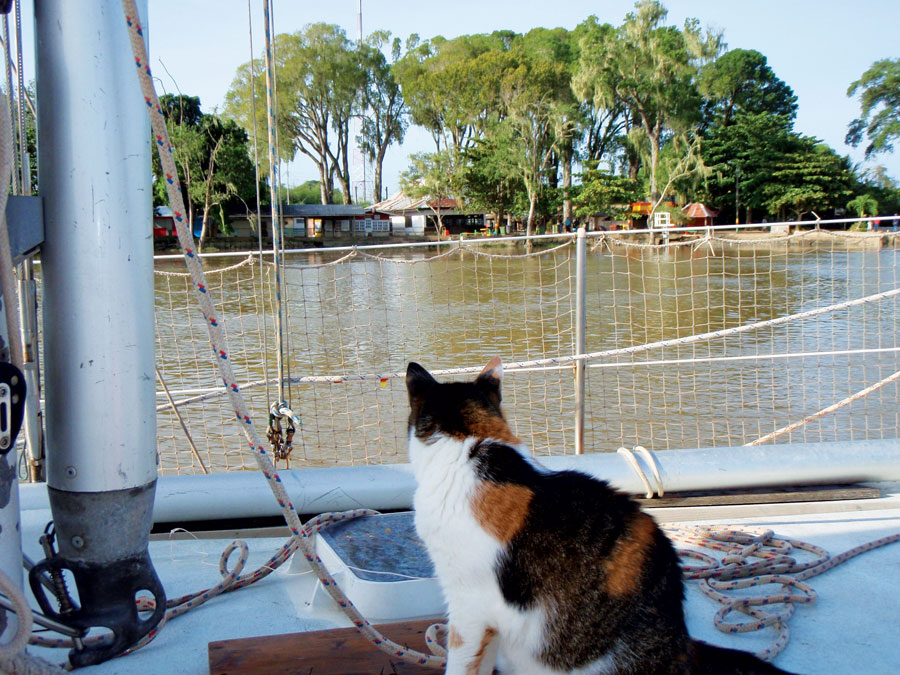When we started out cruising the world we were inexperienced sailors. Most of our friends and acquaintances who had no idea about sailing were horrified by the image of a small sailboat all alone on a big ocean, those who had some idea immediately asked whether we’d at least join a rally for safety on the Atlantic crossing to the Caribbean.

Before we set out cruising we devoured books by pioneers like the Smeetons, Pardeys and Hal Roth who emphasized the necessity to be self-sufficient and prepared to deal with problems using your own skills and means. Route planning as well as studying pilot charts to get a feeling for weather patterns is part of that, facilitated by the various forecast models modern sailors have access to. Comparing info we quickly found that we neither liked the starting date of the Atlantic Rally for Cruisers (ARC), nor their route. It may sound uppity for two newbie sailors to question a well-established rally, but the direct route from the Canary Islands to the Caribbean is not the best access to the trade winds and November is too early to expect stable conditions. Quite often the ARC fleet drifts into calm weather and the year before they limped into Mindelo harbor (Cape Verdes) for repairs after getting battered by heavy weather.

We opted for the traditional detour via the Cape Verde Islands (following the old adage to sail south until the butter melts) and spent some time in Mindelo. Preparations and weather were the only topics at sundowners and everybody got increasingly nervous with some crews already setting off with a “See you on the other side” while others were still hesitating. We left the buzz of Mindelo and sailed down to tiny Brava, the westernmost island of the Cape Verde Islands where we spent an enjoyable month anchored off a little fishing village. The impending Atlantic crossing seemed distant once more. Only when our hikes took us to the steep shores, the high waves with white caps on top were a reminder that we’d soon have to brave that long stretch of blue.
How to Plant and Maintain a Garden on a Cruising Boat – Fresh salad?

We were mostly alone in ‘our’ bay, but one day a little ferrocement boat anchored close by and we were astonished to learn that the young female skipper would single-handedly deliver ‘the swimstone’ (as she affectionately called the boat) to South Africa via the Caribbean. It was her eighth Atlantic crossing and we sought advice from such an experienced skipper. She only laughed about weather forecasts: “What should go wrong when you cross the Atlantic at the end of December? It’s blowing from the East!” With that refreshing view of things we celebrated Christmas and a few days later we lifted the anchor. The forecast looked good (yes, we still checked daily despite her optimistic advice), Pitufa was prepared and we felt mentally ready.

We set out under poled-out twin genoas and soon Pitufa was rushing along at seven knots in a steady 20 knot breeze. We celebrated the New Year with a sip of bubbly at midnight, then switched to the next time zone and had another sip one hour later. Everything seemed perfect, when on the third day suddenly the shaft of our Hydrovane self-steering broke. All efforts to fix it with braces failed under the force of two meter high following seas that made work under the transom precarious and snapped off all reinforcements. We had never bothered to repair our dodgy electric autopilot, as it was hardly ever in use anyway. It would steer the boat for ten minutes and then quit with accusing beeps. We were exhausted, desperate and would have happily accepted help. But then, how could a rally have assisted? They could hardly have organized a new shaft for our windvane or delivered a new autopilot.
Sailing back against the wind didn’t appeal to us and trying to get Pitufa to steer herself with balanced sails would have meant a risk of broaching. Instead we started hand-steering in two-hour shifts and the seemingly impossible task became routine. We drank buckets of hot tea, used the autopilot for quick breaks and munched constantly. Cloudy nights with nothing to focus on but the dancing numbers on the compass were the hardest. The winds remained strong and steady and our arrival in Suriname 11 days later was the happiest in our cruising life.
What Anchoring Equipment Do we Use? – Material & Basic Maneuvers

In hindsight we should not have left without a back-up autopilot, but the timing as well as the route could not have been better and we would again sail alone. Rallies help with seminars on useful topics and the sense of camaraderie makes jumping off easier. Unfortunately fixed dates can send a whole fleet into suboptimal conditions. The sense of safety a rally gives can be deceiving and the feeling of despair more painful when the expected AAA doesn’t turn up. In the end every crew must handle their problems alone.
Birgit, Christian and ship’s cat Leeloo set out from Europe in 2011 and crossed the Atlantic in December 2011 and are now cruising in and around French Polynesia. For more on Pitufa, visit: www.pitufa.at!





